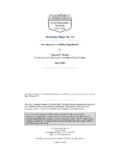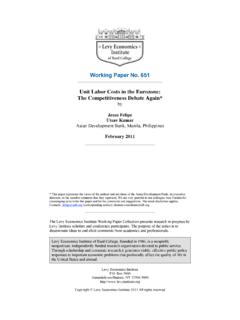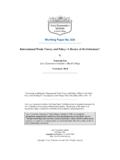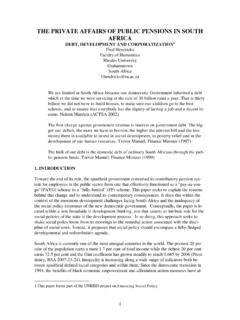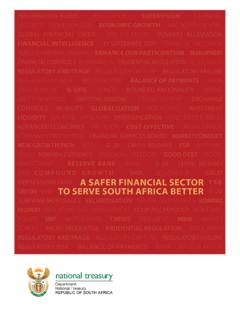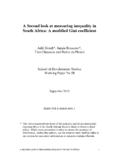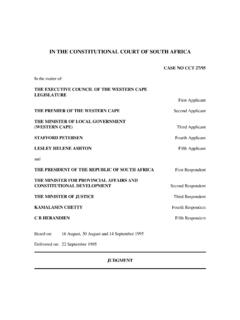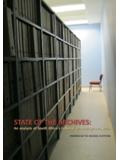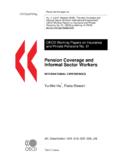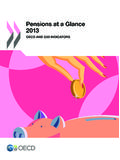Transcription of THE SOUTH AFRICAN EXPANDED PUBLIC WORKS …
1 1 Maikel R. Lieuw-Kie-Song (Former Chief Director EPWP Unit, SA) Conference on Employment Gaurantee Policies 22 June 2009, Levy Institute, NY, USA THE SOUTH AFRICAN EXPANDED PUBLIC WORKS PROGRAMME (EPWP) 2004-2014 2 1- SOUTH AFRICAN Context Important to understand the choices made in design of the EPWP 2- First phase of the EPWP 2004-2009 Consolidated the role of PUBLIC WORKS programmes 3- Second phase of EPWP 2009-2014 Steady Expansion 4- Some lessons learned to date STRUCTURE OF PRESENTATION 3 Large areas and segments of the population were excluded from the economy and remain very poor til today Large proportion of the population remains poorly skilled, despite large investments in education since 1994 This has resulted in Extremely high unemployment rates along (23-40%) with Low labour participation rate Main pillars of the economy (mining and agriculture)
2 Have become less labour intensive, partially due to rapid integration into global economy Job Creation programmes since 1994 have included the Reconstruction and Development Programme (94-99), Special Poverty Relif Allocation (99-2004) and EPWP (2004-2014 and beyond) SOUTH africa S CONTEXT 4 4 PERMANENT million CORE OUTSOURCED million TEMP/PART-TIME/CASUAL NON-CORE PERIPHERY UNEMPLOYED million INFORMAL WORK million Working age population: million, Economically Active Population million Unskilled = million (incomplete Secondary School) Skilled: million (High School or above) EMPLOYMENT & UNEMPLOYMENT Official Unemployed: 4 350 000 Discouraged Workseekers 3 503 000 EPWP outputs 2007-08: 440 000 work opportunities and 148 000 person-years of employment Unemployment rates: Official: Broad (incl.)
3 Discouraged work-seekers): 5 Large system of social grants to individuals in place in SOUTH africa (Note 1 USD=+- R10): Disability grants R940 (includes those too sick to work because of AIDS) Old Age pensions R940 (all over 65 being reduced to 60) Child Support Grants: R220 (for every child up to 15) Foster Care Grants: R650 for foster parents taking in children/ orphans 13 million beneficiaries out of a population of 47 million All the Social Grants combined in 2008-09 are budgeted at R69 billion. This represents of GDP and 10% of the total government budget Excludes housing subsidies, free water and electricity, school feeding programmes etc. Considerable resistance to more social spending 5 CASH TRANSFERS IN SOUTH africa 6 Reconstruction and Development Programme (94-99): Main programme of the new government in 1994 Serious difficulties with institutional design: unclear where RDP ended and normal government functions began: Eg: Was Housing an RDP programme or a programme of the Ministry of Housing Institutional confusion led to the closure of the RDP office and Ministry Conclusion.
4 These functions to be run by respective mandated departments and parallel functions don t work Special Poverty Relief Allocation (99-04) Departments bid for special funds for poverty relief projects that fall within their mandate Limited impact because of size of allocation Limited use of normal Departmental budgets poverty and employment programmes despite large potential Conclusion: Poverty and Employment programme to be mainstreamed into normal mandates and not-treated as an aside 6 PRECURSORS TO EPWP 7 7 New: no more separate budgets, but employment creation projects to be funded from line budgets Cautious in the sense that it was widely recognised that EPWP was small in relation to size of the problem, but there was skepticism if new PUBLIC WORKS approach could work Key issues influenced the design: Experiences, especially institutional difficulties over 1994-2004 Any increases in budgets to be motivated together with line function departments Nature of work: Work must addresses large government prioritised deficits in infrastructure and social and environmental services (in line with line budgets) without fueling fears of displacement within and casualisation of the PUBLIC sector EPWP 1 (04-09).
5 CAUTIOUS NEW APPROACH 8 1. Decentralised all of government programme: national, provincial and local government are expected to contribute to the 1 million target over 5 years 2. Objective was to provide income and training to enable people to move into other work (exit) through provision of infrastructure and services 3. Use of Special Employment Framework to distinguish from PUBLIC service and other formal employment: maximum duration of employment, allowance for lower wages, training entitlement, no unemployment insurance 4. No special budgets: additions to existing budgets and conditional intergovernmental mechanisms and mobilisation for provincial and municipal government to use their own budgets as well: a) Employment creation to be mainstreamed in core function of government, not a parallel/ peripheral function b) Limit establishment of separate/ parallel institutions for implementation c) Focus on maintaining productivity and limit risk of make work-programmes 8 KEY DESIGN FEATURES OF EPWP 1 (04-09) 9 5.
6 Four sectors focusing on different areas of implementation: a. Infrastructure: mostly provincial and local infrastructure suitable to the use of labour-intensive methods; roads, water provision, sanitation, schools, parks, sport fields b. Environmental: Removal of invasive alien vegetation (Working for Water), Fire protection, wetland rehabilitation, greening, coastal cleaning etc. c. Social: Early Childhood Development, Home and Community Based Care d. Economic: Small Enterprise Development through government procurement 7. EPWP Unit in Department of PUBLIC WORKS responsible for a. Programme design b. Coordination and Mobilisation c. Monitoring and Evaluation d. Communication e. Technical Support f. Reporting back to Cabinet 9 KEY DESIGN FEATURES OF EPWP 1 (04-09) 10 Part of the design impact of the EPWP was not to separate the EPWP from MDG related investments Conditional infrastructure grants are meant for basic infrastructure, as well as education and health facilities (MDG 2,4,5) ECD and HCBC activities contribute to health, education and gender equity objectives of the MDG s (MDG 2,3,4,5 &, 6) Environmental sector programmes promote environmental sustainability (MDG 7) EPWP to complement and add weight to MDG related investments: EPWP supports motivations in budget increases: Infrastructure grant budgets: 04-05: R billion ==> 09-10: billion Expenditure: Social Sector: 04-05.
7 R 19 million ==> 07-08: R 630 million Environmental sector: 04-05: R 643 million ==> 07-08: billion All EPWP Expenditure: 2004-05 billion ==> 2007-08: R billion REAL INCREASES WITHOUT SEPARATE BUDGETS 10 LINKS TO MDGS 11 11 Average age: Male/ Female Participation: 54%/ 46% Household income before EPWP R500-R900 (US$ 50-US$90) Household income during EPWP R900-R2000 (US$ 90- US$ 200) About half of beneficiaries were Head of the Household, (Typically other half supplementing the income of Head of Household) Average household size: Average number of children in household below 18: More than 30% have an education level of grade 12 or above 73% were unemployed before EPWP, 12 % left part time/ casual employment, 4% left full-time employment, 7% were students EPWP BENEFICIARY PROFILE 12 12 WORK OPPORTUNTIES AND UNEMPLOYED 07-08 Province EPWP work opportunities No.
8 Unemployed official definition EPWP work opportunities as % of unemployed KwaZulu-Natal 109,273 938,000 12% Western Cape 49,584 368,000 13% Gauteng 67,363 926,000 7% Eastern Cape 83,281 449,000 18% Mpumalanga 26,245 292,000 9% Free State 24,745 267,000 9% Limpopo 20,133 331,000 6% North West 25,241 270,000 9% Northern Cape 16,549 105,000 16% Totals 440,246 3,945,000 11% Big differences in performance between provinces, even bigger between municipalities! Expenditure on EPWP: of GDP, of Government Expenditure SIGNIFICANT BUT NOT ENOUGH 13 Duration of work opportunities is shorter than anticipated: less income per beneficiary & less work experience, especially in areas with high unemployment rates where there is pressure to rotate jobs Training targets and objectives were difficult and ambitious In the current framework DPW has very limited authority or means of providing incentives to lead growth of the programme Integrating EPWP into line function budgets sometimes reduces appetite for risks.
9 Making things more labour intensive sometimes perceived as higher risk Non uniform wage structure & employment conditions create operational difficulties Social sector institutional issues: PUBLIC sector/ formal/ informal/ permanent/ temporary Capacity of some implementing bodies, especially in those areas of need is limited technical support and and capacity building should not be underestimated: Importance for success of programme Costs of providing support Difficulties for making support effective and efficient 13 REVIEW OF EPWP 1 14 14 There is wide support for the EPWP, but all with caveats: Business: YES (But with concerns about budget deficits/ social spending) Upper and middle class: YES (But with skepticism that government can deliver and it will not just be make work) Fiscal conservatives in government: YES (But as long as it aligns with other fiscal priorities) Labour (unions): YES (But as long as it does not erode wages and working conditions or displaces members) Progressives: YES (But it is far too small, jobs are not sustainable/ decent ) Poor unemployed: YES (But we want more) WHO SUPPORTS THE EPWP IN SOUTH africa ?
10 In addition the discourse has often been framed as a choice between EPWP and a Basic Income Grant for working age adults rather than how these could complement each other 15 Annual Targets Cumulative Targets 09/10 500 000 500 000 10/11 600 000 1 100 000 11/12 800 000 1 900 000 12/13 1 100 000 3 000 000 13/14 1 500 000 4 500 000 Increase average duration to 100 days per work opportunity Introduce national minimum wage level Include wider range of activities Focus only on training required to do work Expand to Non-State (NGO s and CBO s) to contribute to employment creation Introduction of a intergovernmenal wage incentive to speed up growth and incetivise other spheres of government EPWP 2: (2009-14) New Five Year Targets 16 Introduction of a Intergovernmental Fiscal Wage Incentive to drive programme growth and work duration: All implementing government bodies can claim R50 per person-day of work created in all sectors and activities If they pay a higher wage they pay difference from their own funds Not allowed to pay a below R 50 or claim for wage above R126 Once received, use of wage incentive discretionary Wage incenti


